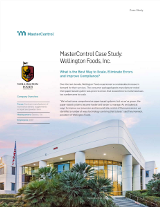
GxP Lifeline
Top 5 Nutraceutical Trends in 2018 - Getting Creative With Protein
Protein is easily the trendiest macronutrient, no longer the obsession of only athletes and bodybuilders. Most consumers are now worried about protein consumption and are convinced that they need to be getting more protein in their diet. An increasing number are also looking for protein sources that don’t involve meat and dairy. For vegetarians and vegans, options are limited, but innovative plant sources are becoming more and more popular. Given the increased demand, manufacturers are not only diversifying the sources of protein that they use, but also the kinds of high-protein foods that they offer their consumers.
Insect Protein and Sustainability
Perhaps the most unique form of protein currently in use is insect protein. While not vegetarian- or vegan-friendly, this option is considered more sustainable than meat. Beetles, crickets and mealworms are forming the base of a trendy protein source that the Western world is only beginning to tap into. This might be a new market, but its projected growth rate is huge — expected to reach $520 million by 20231. The biggest obstacle to this market is the stigma associated with eating bugs. It certainly helps that the bugs are usually in a powder form, but it will still take time for consumers in general to become comfortable with the idea.
Speaking of sustainable practices, “sustainable” is quickly becoming one of the most popular words in marketing and public relations. Every company wants to be sustainable because that’s what attracts consumers. Even if consumers don’t know exactly what it means, they know they want sustainability. The concept of sustainability has spread far beyond the dictionary definition to include, among other things, 1) ethical treatment of animals, 2) lack of pesticides, 3) supporting the local economy, 4) organic certification, and 5) recognizable, easy-to-pronounce ingredients3. So, when you include crickets in your products, be sure to refer to them as crickets and not Gryllus pennsylvanicus.
New Trends in High-Protein Foods
Protein bars and shakes are nothing new, but protein pancakes, cookies, chips and breads are more recent developments in the market. The current trend shows that consumers want snacks and baked goods that are high in protein (containing at least 10 grams per serving)2, indicating that consumers are anxious to find and enjoy guilt-free versions of their favorite snack foods. Most of these foods use plant-based protein in the form of grains, pulses, nuts and legumes. One of the challenges facing this market is to formulate a recipe that tastes good and delivers the maximum amount of protein. For example, using bean flour lends a flavor to food that may be undesirable, especially in baked goods that are meant to be sweet.
Speaking of flavor, anything with an unusually high amount of protein is bound to taste like it has an unusually high amount of protein. This is one of the concerns that formulators must address when developing new products. Whether the protein source is animal, vegetable or mineral, there’s typically no mistaking the taste — and that’s a bad thing. If a company wants to quickly make a name for itself in this market, developing a product that doesn’t have that distinctive protein taste will be hugely successful.
Where Nutraceutical Companies Fit In
Larger nutraceutical companies are likely dabbling in at least the protein powder market already. Meal-replacement powders have been a hot category for years, but expanding into prepared beverages and foods presents new opportunities. An additional benefit is that all of these products fall under the natural umbrella, which means the same group of consumers who are shopping for dietary supplements are also looking for protein-fortified foods, beverages and powders. When competing against food manufacturers, nutraceutical manufacturers’ biggest advantage is their familiarity with clean ingredients and formulas. This is most advantageous when dealing with powders, since consumers who buy powders are more concerned with ingredients than those who buy foods or beverages. Successful firms will be the ones that can produce the best-tasting, cleanest product with the highest amount of protein.
Build on the Quality System You Have
To successfully move into a new category, companies must apply the quality controls they currently use to the new products. A company with a good quality management system (QMS) would easily be able to change its standard operating procedures (SOPs), train employees on the new products, qualify its suppliers, and register its customer complaints for continuous improvement. For companies that have challenges in these areas, implementing an electronic QMS is the best way to start. Once a company has made the most of its current process, including changing or eliminating less efficient processes, it can expand that into new areas. A nutraceutical company that has perfected its supplement quality management is in the perfect position to begin producing high-protein foods, drinks and powders.
A QMS can also help a company build up its image as “sustainable.” It’s very easy to put that word on packaging or on the “About Us” section of a company website, but consumers have the know-how to quickly see if you have anything backing up that statement. And for you to be sustainable, your entire supply chain must be sustainable as well. An interconnected supplier management system will help a nutraceutical company keep track of its suppliers and ensure that their processes are sustainable. Implementing these tools will help companies produce high-quality high-protein products and improve their overall image in the public eye.
- Rutberg, Shara, “Beetlemania: Edible bugs heading to $520M,” January 3, 2017. http://www.newhope.com/breaking-news/beetlemania-edible-bugs-heading-520m
- Berry, Donna, “Snacks powered by protein,” July 11, 2017. https://www.foodbusinessnews.net/articles/9656-snacks-powered-by-protein
- Schlueter, Ginger, “2017 Study Finds Consumers Familiarity With Sustainability Reached All-Time High,” May 25, 2018. https://www.naturalproductsinsider.com/business-resources/2017-study-finds-consumer-familiarity-sustainability-reached-all-time-high

